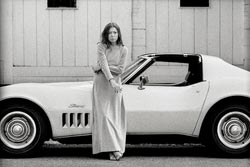Larry Cohen
Recent Plein Air Paintings
Driving L.A.
Group Show
Images from Exhibition
LA Times Review
Tim Bradley, Jeff Brouws,
Sean Hiller,
E.O. Hoppé,
John Humble,
Michael Light,
Malcolm Lubliner,
Richard C. Miller,
Jerry McMillan,
Marvin Rand,
Julius Shulman,
Marvin Silver,
John Swope,
Mark Swope
George Tate,
Julian Wasser
July 12 - August 23, 2014
Reception: July 12, 2014 4-6PM
In 1970, Julian Wasser photographed Joan Didion for the release of her new book, Play It As It Lays. The novel’s main character, Maria, is addicted to L.A. freeways, being sedated by their rhythms and currents, not going anywhere, but driving with the radio at high volume. In her dreams, “the great signs soar overhead at 70 miles an hour, Normandie ¼ Vermont ¾ Harbor Fwy 1.” In Wasser’s photograph, Didion looks somewhat disdainful, standing in front of her white Corvette, smoking her cigarette. Her terse writing style, and car, correspond to Maria and her driving obsession, “So that she would not have to stop for food she kept a hard-boiled egg on the passenger seat of the Corvette.”
If we subscribe to the poet Gary Snyder’s dictum that “our place is part of what we are,” then certainly the blood running through our veins is equal to the traffic flowing through the city’s arteries. The nature of our existence relative to cars, driving, and our complex network of roads, has been explored from MOCA’s 1984 exhibition The Automobile in Culture to the Getty’s 2013 exhibition, Overdrive: L.A. Constructs the Future 1940-1990.
Driving L.A., a group exhibition of photographs by sixteen artists represented by Craig Krull Gallery will, of course, include pictures made while driving, but it will also explore our lifestyles and built environments as they have taken shape on the streets of L.A. in the form of billboards, dingbats, car washes, drive-ins, freeways and maps-to-the-stars’-homes. But the driving culture of L.A. also includes those stationary cars on Hollywood studio sound stages with a film of passing scenery running behind them. It also includes an imagined L.A., as exemplified by Tim Bradley’s staged photo of a model he created of an El Camino with the giant framework of a church under construction on its bed. It is a haunting combination of our peripatetic lives and our often bizarre history of cults and pop-up religions.
Concurrently, in the adjoining galleries, Larry Cohen will present his latest plein air paintings of Southern California, or as they say in Hollywood, made “on location.” In fact, Cohen is recognized as one of the most accomplished plein air painters of our constructed environment. Over the course of his four-decade career, Cohen has, like Monet and his haystacks, painted the same scenes and perspectives at various times of day and in a range of atmospheric conditions. As Lawrence Weschler suggested in his 1998 article L.A. Glows, there is something unique about the light in L.A. Larry Cohen’s work serves as witness to the phenomenon.

